
Ophthalmology is a clinical and surgical specialty within medicine that deals with the diagnosis and treatment of eye disorders. A former term is oculism.
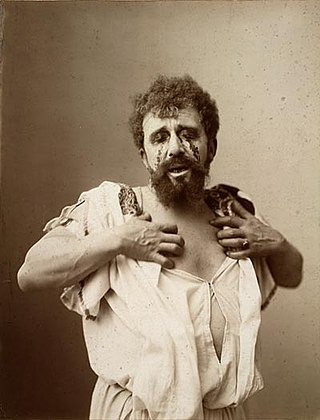
Oedipus Rex, also known by its Greek title, Oedipus Tyrannus, or Oedipus the King, is an Athenian tragedy by Sophocles that was first performed c. 429 BC. Originally, to the ancient Greeks, the title was simply Oedipus (Οἰδίπους), as it is referred to by Aristotle in the Poetics. It is thought to have been renamed Oedipus Tyrannus to distinguish it from Oedipus at Colonus, a later play by Sophocles. In antiquity, the term "tyrant" referred to a ruler with no legitimate claim to rule, but it did not necessarily have a negative connotation.

Lucia of Syracuse (283–304), also called Saint Lucia was a Roman Christian martyr who died during the Diocletianic Persecution. She is venerated as a saint in Catholic, Anglican, Lutheran, and Eastern Orthodox Christianity. She is one of eight women explicitly commemorated by Catholics in the Canon of the Mass. Her traditional feast day, known in Europe as Saint Lucy's Day, is observed by Western Christians on 13 December. Lucia of Syracuse was honored in the Middle Ages and remained a well-known saint in early modern England. She is one of the best known virgin martyrs, along with Agatha of Sicily, Agnes of Rome, Cecilia of Rome, and Catherine of Alexandria.
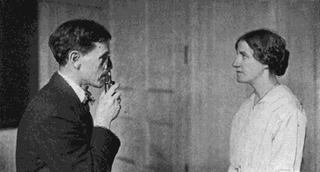
The Bates method is an ineffective and potentially dangerous alternative therapy aimed at improving eyesight. Eye-care physician William Horatio Bates (1860–1931) held the erroneous belief that the extraocular muscles effected changes in focus and that "mental strain" caused abnormal action of these muscles; hence he believed that relieving such "strain" would cure defective vision. In 1952, optometry professor Elwin Marg wrote of Bates, "Most of his claims and almost all of his theories have been considered false by practically all visual scientists."

Eye surgery, also known as ophthalmic surgery or ocular surgery, is surgery performed on the eye or its adnexa. Eye surgery is part of ophthalmology and is performed by an ophthalmologist or eye surgeon. The eye is a fragile organ, and requires due care before, during, and after a surgical procedure to minimize or prevent further damage. An eye surgeon is responsible for selecting the appropriate surgical procedure for the patient, and for taking the necessary safety precautions. Mentions of eye surgery can be found in several ancient texts dating back as early as 1800 BC, with cataract treatment starting in the fifth century BC. It continues to be a widely practiced class of surgery, with various techniques having been developed for treating eye problems.

Visual or vision impairment is the partial or total inability of visual perception. In the absence of treatment such as corrective eyewear, assistive devices, and medical treatment – visual impairment may cause the individual difficulties with normal daily tasks including reading and walking. The terms low vision and blindness are often used for levels of impairment which are difficult or impossible to correct and significantly impact daily life. In addition to the various permanent conditions, fleeting temporary vision impairment, amaurosis fugax, may occur, and may indicate serious medical problems.

Enucleation is the removal of the eye that leaves the eye muscles and remaining orbital contents intact. This type of ocular surgery is indicated for a number of ocular tumors, in eyes that have sustained severe trauma, and in eyes that are otherwise blind and painful.

Eye-gouging is the act of pressing or tearing the eye using the fingers or instruments. Eye-gouging involves a very high risk of eye injury, such as eye loss or blindness.

Patricia Era Bath was an American ophthalmologist and humanitarian. She became the first female member of the Jules Stein Eye Institute, the first woman to lead a post-graduate training program in ophthalmology, and the first woman elected to the honorary staff of the UCLA Medical Center. Bath was the first African-American to serve as a resident in ophthalmology at New York University. She was also the first African-American woman to serve on staff as a surgeon at the UCLA Medical Center. Bath was the first African-American woman doctor to receive a patent for a medical purpose. A holder of five patents, she founded the non-profit American Institute for the Prevention of Blindness in Washington, D.C.
Oculoplastics, or oculoplastic surgery, includes a wide variety of surgical procedures that deal with the orbit, eyelids, tear ducts, and the face. It also deals with the reconstruction of the eye and associated structures.
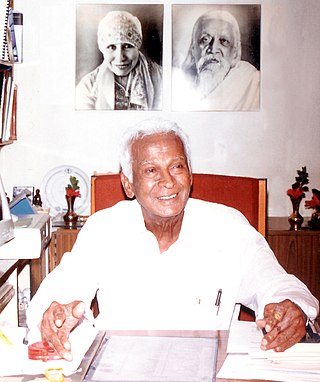
Govindappa Venkataswamy, popularly known as Dr V., was an Indian ophthalmologist who dedicated his life to eliminate needless blindness. He was the founder and former chairman of Aravind Eye Hospitals. He is best known for developing a high quality, high volume, low-cost service delivery model that has restored sight to millions of people. Since inception, Aravind Eye Care System has seen over 55 million patients, and performed over 6.8 million surgeries. Over 50% of the organisation's patients pay either nothing or highly subsidised rates. Its scale and self-sustainability prompted a 1993 Harvard Business Case Study on the Aravind model.
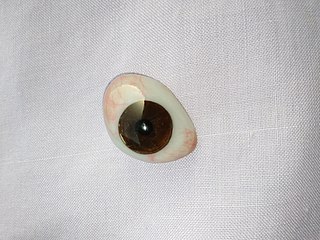
An ocular prosthesis, artificial eye or glass eye is a type of craniofacial prosthesis that replaces an absent natural eye following an enucleation, evisceration, or orbital exenteration. The prosthesis fits over an orbital implant and under the eyelids. Though often referred to as a glass eye, the ocular prosthesis roughly takes the shape of a convex shell and is made of medical grade plastic acrylic. A few ocular prostheses today are made of cryolite glass. A variant of the ocular prosthesis is a very thin hard shell known as a scleral shell which can be worn over a damaged or eviscerated eye. Makers of ocular prosthetics are known as ocularists. An ocular prosthesis does not provide vision; this would be a visual prosthesis. Someone with an ocular prosthesis is altogether blind on the affected side and has monocular vision.

Nystagmus is a condition of involuntary eye movement. People can be born with it but more commonly acquire it in infancy or later in life. In many cases it may result in reduced or limited vision.
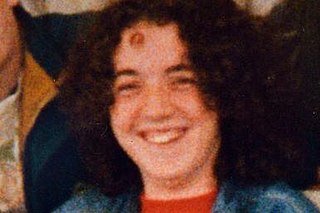
Kelly Anne Bates was an English teenager who was murdered in Manchester, England at the age of 17 by her abuser, James Patterson Smith. She was tortured by him over a period of four weeks, including having her eyes gouged from their sockets up to three weeks before her death, before being drowned in a bathtub.

Sanduk Ruit is an ophthalmologist from Nepal who was involved to restore the sight of over 180,000 people across Africa and Asia using small-incision cataract surgery.

Blinding is a type of physical punishment which results in complete or nearly complete loss of vision. It was used as an act of revenge and torture. The punishment has been used since Antiquity; Greek mythology makes several references to blinding as divine punishment, which reflects human practice.

Bharti Kashyap Navigating Health Care Reform in Jharkhand From a crusader against blindness to Cervical cancer activist the extraordinary success and figures of cervical cancer eradication campaign, eye donation awareness campaign, diabetic retinopathy screening, “Jyot Se Jyot Jalao” campaign and vision protection campaign being run in Jharkhand over the past three decades by Dr. Bharti Kashyap is a testament to the fact that she has carried out the campaigns with full devotion and dedication and has successfully achieved the set targets. Nari Shakti puruskar Awardee Dr Bharti Kashyap is an Indian ophthalmologist and great family and child welfare social worker in Jharkhand, also known as vision and Janni suraksha Lady. She is honoured with Nari Shakti Puraskar in 2017 by hon'ble president of India and is a five-time recipient of the National IMA Award for the welfare of the underprivileged section of society
Visual impairment in art is a limited topic covered by research, with its focus being on how visually impaired people are represented in artwork throughout history. This is commonly portrayed through the inclusion of objects such as canes and dogs to symbolize blindness, which is the most frequently depicted visual impairment in art. Many notable figures in art history, such as Leonardo da Vinci, Claude Monet, and Georgia O'Keeffe, were visually impaired, or theorized to be so.

The theme of blindness has been explored by many different cultures throughout history, with blind characters appearing in stories from ancient Greek mythology and Judeo-Christian religious texts. In the modern era, blindness has featured in numerous works of literature and poetry by authors such as William Shakespeare, William Blake, and H. G. Wells, and has also been a recurring trope in film and other visual media.
Sheila Kay West is an American ophthalmologist who is the El-Maghraby Professor of Preventive Ophthalmology at the Wilmer Eye Institute. She is also the vice-chair for Research.

















